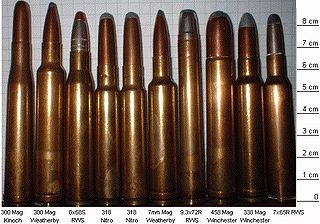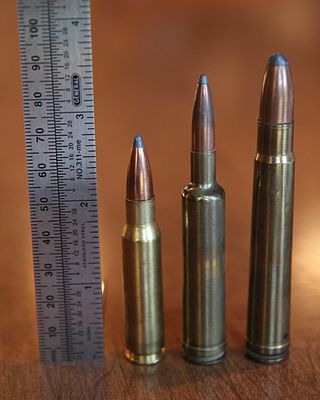The scout rifle is a conceptual class of general-purpose rifles defined and promoted by Jeff Cooper in the early 1980s that bears similarities in the design and functionality of guide guns, mountain rifles, and other rifle archetypes, but with more emphasis being placed on comfortable portability and practical accuracy, rather than firepower and long range shooting.
The Steyr Scout is an Austrian bolt-action rifle manufactured by Steyr Mannlicher, and chambered primarily for 7.62 NATO, although other caliber options in 5.56×45mm NATO, .243 Winchester, 6.5 Creedmoor, .376 Steyr and 7mm-08 Remington are also offered commercially. It is intended to fill the role of a versatile, lightweight all-around rifle as specified in Jeff Cooper's scout rifle concept. Apart from the barrel and action, the gun is made primarily of polymers and is designed to be accurate to at least 800 m (870 yd).

This is a list of firearm cartridges that have bullets in the 9 millimeters (0.35 in) to 9.99 millimeters (0.393 in) caliber range.

The .410 bore (10.4 mm) is one of the smallest caliber of shotgun shell commonly available. A .410 bore shotgun loaded with shot shells is well suited for small game hunting and pest control. The .410 started off in the United Kingdom as a garden gun along with the .360 and the No. 3 bore (9 mm) rimfire, No. 2 bore (7 mm) rimfire, and No. 1 bore (6 mm) rimfire. .410 shells have similar base dimensions to the .45 Colt cartridge, allowing many single-shot firearms, as well as derringers and revolvers chambered in that caliber, to fire .410 shot shells without any modifications.

The .460 Weatherby Magnum is a belted, bottlenecked rifle cartridge, developed by Roy Weatherby in 1957. The cartridge is based on the .378 Weatherby Magnum necked up to accept the .458-inch (11.6 mm) bullet. The original .378 Weatherby Magnum parent case was inspired by the .416 Rigby. The .460 Weatherby Magnum was designed as an African dangerous game rifle cartridge for the hunting of heavy, thick skinned dangerous game.
The Mannlicher–Schönauer is a rotary-magazine bolt-action rifle produced by Steyr Mannlicher for the Greek Army in 1903 and later used in small numbers by the Austro-Hungarian Army. Post-war it was sold for civilian use.

The .458 Winchester Magnum is a belted, straight-taper cased, Big Five game rifle cartridge. It was introduced commercially in 1956 by Winchester and first chambered in the Winchester Model 70 African rifle. It was designed to compete against the .450 Nitro Express and the .470 Nitro Express cartridges used in big bore British double rifles. The .458 Winchester Magnum remains one of the most popular large game cartridges, and most major ammunition manufacturers offer a selection of .458 ammunition.

The .257 Weatherby Magnum is a .257 caliber (6.53 mm) belted bottlenecked cartridge. It is one of the original standard length magnums developed by shortening the .375 H&H Magnum case to approx. 2.5 in (64 mm). Of the cartridges developed by Roy Weatherby, the .257 Weatherby Magnum was known to have been his favorite, and the cartridge currently ranks third in Weatherby cartridge sales, after the .30-378 Weatherby Magnum and the .300 Weatherby Magnum.

The .375 H&H Magnum, also known as .375 Holland & Holland Magnum, is a medium-bore rifle cartridge introduced in 1912 by London based gunmaker Holland & Holland. The .375 H&H cartridge featured a belt to ensure the correct headspace, which otherwise might be unreliable, given the narrow shoulder of the cartridge case. The cartridge was designed to use cordite which was made in long strands – hence the tapered shape of the case, which, as a beneficial side effect also helped in smooth chambering and extraction from a rifle's breech.

The 7mm Remington Magnum rifle cartridge was introduced as a commercially available round in 1962, along with the new Remington Model 700 bolt-action rifle. It is a member of the belted magnum family that is directly derived from the venerable .375 H&H Magnum. The original purpose of the belted magnum concept taken from the .300 H&H Magnum and .375 H&H Magnum, was to provide precise headspace control, since the sloping shoulders, while easing cartridge extraction, were unsuitable for this purpose. Improved cartridge extraction reliability is desirable while hunting dangerous game, in particular when a fast follow-up shot is required. The 7mm Remington Magnum is based on the commercial .264 Winchester Magnum, .338 Winchester Magnum, and .458 Winchester Magnum, which were based on the same belted .300 H&H Magnum and .375 H&H Magnum cases, trimmed to nearly the same length as the .270 Weatherby Magnum.

The 8mm Remington Magnum belted rifle cartridge was introduced by Remington Arms Company in 1978 as a new chambering for the model 700 BDL rifle. The 8mm Remington Magnum's parent case is the .375 H&H Magnum. It is a very long and powerful cartridge that cannot be used in standard length actions, such as those that accommodate the .30-06 Springfield.

The 9.5×57mm Mannlicher–Schönauer (MS) cartridge was adopted for the M-1910 MS rifle and carbine in 1910. The 9.5×57mm MS is also known as the 9.5×56mm MS, the 9.5×56.7mm MS, and the .375 Rimless Nitro Express (RNE) × 2¼. The cartridge may have been created by Westley-Richards and Eley in 1908, but no production rifles in this caliber have been found prior to the M-1910. This development by or on behalf of Steyr was probably an answer to the development by the noted British gunmaking firm of Holland & Holland in 1905 of their .400/375 Belted Nitro Express, designed for their specially modified Mannlicher–Schoenauer rifle. Whether the development of the 9.5×57mm Mannlicher–Schoenauer cartridge originated with OWS or with Holland's British competitor, Westley Richards certainly was the principal promoter of the new 1910 Model Mannlicher–Schoenauer rifle as evidenced by catalogs of the time. The 9.5×57mm MS is the last pre-war proprietary cartridge by Steyr and their most powerful until the recent advent of the .376 Steyr, which has its antecedents in the 9.5×57mm.
The .300 H&H Magnum cartridge was introduced by the British company Holland & Holland as the Super-Thirty in June, 1925. The case was belted like the .375 H&H Magnum, and is based on the same case, as also is the .244 H&H Magnum. The belt is for headspace as the cases' shoulders have a narrow slope rather than an actual shoulder. More modern magnums continue this practice, but headspacing on the belt is not necessary with their more sharply angled shoulders. The cartridge was used by American shooter Ben Comfort to win the 1000-yard Wimbledon Cup Match at Camp Perry in 1935, and it was used again to win the international 1,000 yard competition in 1937. Winchester chambered the Model 70 in .300 Holland & Holland Magnum in 1937.
The 9.3×64mm Brenneke is a rimless bottlenecked centerfire rifle cartridge designed in 1927 by German gunmaker Wilhelm Brenneke. It is suitable for hunting medium to large game animals in Africa, Asia, Europe, and North America.

The .416 Remington Magnum is a .416 caliber (10.57 mm) cartridge of belted bottlenecked design. The cartridge was intended as a dangerous game hunting cartridge and released to the public in 1989. The cartridge uses the case of the 8 mm Remington Magnum as a parent cartridge. When the cartridge was released in 1988, author Frank C. Barnes considered the .416 Remington Magnum to be the "most outstanding factory cartridge introduced in decades".
The .375 Ruger (9.5×65.5mm) is a rimless, standard-length rifle cartridge designed for hunting large, dangerous game. It is designed to provide an increase in performance over the .375 H&H cartridge within the context of a standard-length rifle action. The cartridge was designed in partnership by Hornady and Ruger. In 2007, it was released commercially and chambered in the Ruger Hawkeye African and the Ruger Hawkeye Alaskan rifles.
The .375 Dakota is dangerous game cartridge designed by Don Allen, the founder of Dakota Arms of Sturgis, South Dakota.

The .458 Lott is a .458 caliber rifle cartridge designed for the purpose of hunting large, thick-skinned dangerous game animals in Africa. It is based on the full length .375 H&H Magnum case blown out and shortened to 2.800 inches (71.1 mm).

The 6.5mm Remington Magnum is a .264 caliber (6.7 mm) belted bottlenecked cartridge introduced in 1966. The cartridge is based on a necked down .350 Remington Magnum which on turn is based on a shortened, necked down, blown out .375 H&H Magnum case. The cartridge was one of the first short magnum cartridges.












